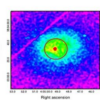Led by Prof. Jaydeep K. Basu from IISc’s Department of Physics, in collaboration with Prof. Shankar Kumar Selvaraja from the Centre for Nano Science and Engineering (CeNSE), and theoretical support from Prof. Girish S. Agarwal at Texas A&M University, the study showcases the integration of Cadmium Selenide (CdSe)-based CQWs with a guided mode MSR. The MSR, fabricated on a silicon nitride (SiN) slab-waveguide platform, features a precise arrangement of holes in a square-lattice geometry. This design enables narrow resonances in both out-of-plane and in-plane directions, effectively tuning the light emission properties of CQWs.
The integration achieved remarkable results, including a 12-fold increase in brightness and a 97% reduction in the width of the emitted light’s spectral line, ensuring unparalleled spectral purity. The enhancement was enabled by the spectral overlap between the MSR’s narrow-band response and the broader emission from CQWs. The platform also demonstrated long-range photon transport across the chip, up to 1 mm, showcasing its potential for creating compact and efficient quantum devices.
“Our work shows how nanoscale materials like CQWs can be seamlessly integrated with photonic structures to achieve exceptional control over light emission and transport, which is critical for the next generation of quantum devices,” said Prof. Basu. The researchers employed a state-of-the-art confocal setup for photoluminescence (PL) measurements, funded by the DST-FIST program, to study enhanced light properties with high precision. The findings have been published in the prestigious journal Advanced Optical Materials.
Looking ahead, the researchers aim to extend this platform to integrate single quantum emitters (SPEs) with MSRs to create highly efficient single-photon sources which are essential for quantum cryptography and quantum information processing.


